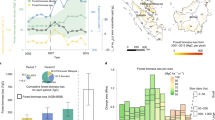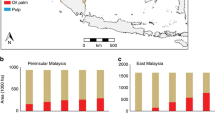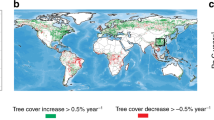Abstract
Oil palm supplies >30% of world vegetable oil production1. Plantation expansion is occurring throughout the tropics, predominantly in Indonesia, where forests with heterogeneous carbon stocks undergo high conversion rates2,3,4. Quantifying oil palm’s contribution to global carbon budgets therefore requires refined spatio-temporal assessments of land cover converted to plantations5,6. Here, we report oil palm development across Kalimantan (538,346 km2) from 1990 to 2010, and project expansion to 2020 within government-allocated leases. Using Landsat satellite analyses to discern multiple land covers, coupled with above- and below-ground carbon accounting, we develop the first high-resolution carbon flux estimates from Kalimantan plantations. From 1990 to 2010, 90% of lands converted to oil palm were forested (47% intact, 22% logged, 21% agroforests). By 2010, 87% of total oil palm area (31,640 km2) occurred on mineral soils, and these plantations contributed 61–73% of 1990–2010 net oil palm emissions (0.020–0.024 GtC yr−1). Although oil palm expanded 278% from 2000 to 2010, 79% of allocated leases remained undeveloped. By 2020, full lease development would convert 93,844 km2 (∼ 90% forested lands, including 41% intact forests). Oil palm would then occupy 34% of lowlands outside protected areas. Plantation expansion in Kalimantan alone is projected to contribute 18–22% (0.12–0.15 GtC yr−1) of Indonesia’s 2020 CO2-equivalent emissions. Allocated oil palm leases represent a critical yet undocumented source of deforestation and carbon emissions.
This is a preview of subscription content, access via your institution
Access options
Subscribe to this journal
Receive 12 print issues and online access
$209.00 per year
only $17.42 per issue
Buy this article
- Purchase on Springer Link
- Instant access to full article PDF
Prices may be subject to local taxes which are calculated during checkout




Similar content being viewed by others
Change history
20 December 2012
In the version of this Letter originally published online, there were several errors in calculations. The net 1990–2010 oil palm emissions given in the abstract should have been 61–73%. In the fire scenario, the increase in cumulative net carbon emissions above the non-fire scenario should have been 24%, and peatland emissions amounted to 35% of gross emissions from 1990–2010. Intact forests on mineral soils converted to oil palm plantations from 1990–2010 (12,072 km2) account for < 1% of Indonesia's land area. These errors have now been corrected in all versions of the Letter.
References
Food and Agriculture Organization of the United Nations FAOSTAT; available at: http://faostat.fao.org (FAO, 2012).
Baccini, A. et al. Estimated carbon dioxide emissions from tropical deforestation improved by carbon-density maps. Nature Clim. Change 2, 182–185 (2012).
Broich, M et al. Remotely sensed forest cover loss shows high spatial and temporal variation across Sumatera and Kalimantan, Indonesia 2000–2008. Environ. Res. Lett. 6, 014010 (2011).
Hansen, M. C. et al. Quantifying changes in the rates of forest clearing in Indonesia from 1990 to 2005 using remotely sensed data sets. Environ. Res. Lett. 4, 034001 (2009).
Gibbs, H. K. et al. Tropical forests were the primary sources of new agricultural land in the 1980s and 1990s. Proc. Natl Acad. Sci. USA 107, 16732–16737 (2010).
Carlson, K. M. et al. Committed carbon emissions, deforestation, and community land conversion from oil palm plantation expansion in West Kalimantan, Indonesia. Proc. Natl Acad. Sci. USA 109, 7559–7564 (2012).
United States Department of Agriculture Indonesia: Rising Global Demand Fuels Palm Oil Expansion (USDA, 2010); available at www.pecad.fas.usda.gov/highlights/2010/10/Indonesia.
Harris, N. L. et al. Baseline map of carbon emissions from deforestation in tropical regions. Science 336, 1573–1576 (2012).
Page, S. E. et al. The amount of carbon released from peat and forest fires in Indonesia during 1997. Nature 420, 61–66 (2002).
Indonesian Ministry of Agriculture Area and Production by Category of Producers: Oil Palm, 1967–2010 (Indonesian Ministry of Agriculture, 2010); available at http://ditjenbun.deptan.go.id.
Paoli, G. D. et al. Policy perils of ignoring uncertainty in oil palm research. Proc. Natl Acad. Sci. USA 108 E218 (2011).
Koh, L. P., Miettinen, J., Liew, S. C. & Ghazoul, J. Remotely sensed evidence of tropical peatland conversion to oil palm. Proc. Natl Acad. Sci. USA 108, 5127–5132 (2011).
Miettinen, J. et al. Extent of industrial plantations on Southeast Asian peatlands in 2010 with analysis of historical expansion and future projections. Glob. Change Biol. (2012).
Curran, L. M. et al. Lowland forest loss in protected areas of Indonesian Borneo. Science 303, 1000–1003 (2004).
Curran, L. M. & Trigg, S. N. Sustainability science from space: Quantifying forest disturbance and land use in the Amazon. Proc. Natl Acad. Sci. USA 103, 12663–12664 (2006).
Lawrence, D. Biomass accumulation after 10–200 years of shifting cultivation in Bornean rain forest. Ecology 86, 26–33 (2005).
Page, S. E., Rieley, J. O. & Banks, C. J. Global and regional importance of the tropical peatland carbon pool. Glob. Change Biol. 17, 798–818 (2011).
Murdiyarso, D., Dewi, S., Lawrence, D. & Seymour, F. Indonesia’s Forest Moratorium: A Stepping Stone to Better Forest Governance? (CIFOR, 2011).
Hooijer, A. et al. Subsidence and carbon loss in drained tropical peatlands. Biogeosciences 9, 1053–1071 (2012).
Murdiyarso, D., Hergoualc’h, K. & Verchot, L. V. Opportunities for reducing greenhouse gas emissions in tropical peatlands. Proc. Natl Acad. Sci. USA 107, 19655–19660 (2010).
Page, S. E. et al. Review of Peat Surface Greenhouse Gas Emissions from Oil Palm Plantations in Southeast Asia (The International Council on Clean Transportation, 2011).
Asner, G. P., Knapp, D. E., Balaji, A. & Páez-Acosta, G. Automated mapping of tropical deforestation and forest degradation: CLASlite. J. Appl. Remote Sens. 3, 033543 (2009).
Fearnside, P. M. Greenhouse gases from deforestation in Brazilian Amazonia: Net committed emissions. Climatic Change 35, 321–360 (1997).
Indonesian National Council on Climate Change Indonesia’s Greenhouse Gas Abatement Cost Curve (Indonesian National Council on Climate Change, 2010).
Van der Werf, G. R. et al. CO2 emissions from forest loss. Nature Geosci. 2, 737–738 (2009).
Oliveira, P. J. C. et al. Land-Use allocation protects the Peruvian Amazon. Science 317, 1233–1236 (2007).
Republic of Indonesia Peraturan Presiden No. 61/2011, Presidential Regulation regarding the National Greenhouse Gas Emission Reduction Action Plan (Republic of Indonesia, 2011).
Busch, J. et al. Structuring economic incentives to reduce emissions from deforestation within Indonesia. Proc. Natl Acad. Sci. USA 109, 1062–1067 (2012).
Republic of Indonesia Instruksi Presiden No. 10/2011, Presidential Instruction Regarding Suspension of Granting New Licenses and Improvement of Natural Primary Forest and Peatland Governance (Republic of Indonesia, 2011).
Indonesian Ministry of Environment Indonesia: The First National Communication on Climate Change Convention (Indonesian Ministry of Environment, 1999).
Acknowledgements
We thank the Indonesian Ministries of Forestry and of Research and Technology, and Provincial Governments, Plantation Departments, Forestry Departments, Statistics Agencies and Land Bodies in Central, East, South and West Kalimantan. D. Ratnasari, S. Lansing, G. Paoli, D. Lawrence, A. Ponette-Gonzalez, J. H. Jones, P. Oliveira, H. Gibbs, J. Clark, D. Knapp, B. Soares-Filho, D. Gaveau, T. Gibbs, D. Gilbert, M. Greenleaf, N. Lisnawati, Y. Purwanto, Ruspita, W. I. Suci, A. Rohman, M. Mugiman, D. Astiani, R. Hartono, U. Abdurrahman, D. Firnata, A. Nirwan and R. Wahyudi provided feedback and fieldwork. L.M.C. acknowledges financial support for this team project from the NASA Land Cover/Land-Use Change Program (NNG05GB51G, NNX11AF08G, NNX07AK37H), John D. and Catherine T. MacArthur Foundation, Santa Fe Institute, Stanford University and Yale University. K.M.C. was financially supported by NASA (NNX08AU75H) and NSF (DGE-1122492) graduate fellowships.
Author information
Authors and Affiliations
Contributions
L.M.C. conceived and designed the project; G.P.A. provided software and designed the land cover classification algorithm; A.M.P., S.N.T., K.M.C. and J.M.A. conducted spatial assessments; K.M.C., A.M.P. and L.M.C. compiled and analysed data; and K.M.C. and L.M.C. wrote the paper.
Corresponding authors
Ethics declarations
Competing interests
The authors declare no competing financial interests.
Supplementary information
Supplementary Information 1
Supplementary Information 1 (PDF 1413 kb)
Supplementary Information 2
Supplementary Information 2 (XLSX 109 kb)
Rights and permissions
About this article
Cite this article
Carlson, K., Curran, L., Asner, G. et al. Carbon emissions from forest conversion by Kalimantan oil palm plantations. Nature Clim Change 3, 283–287 (2013). https://doi.org/10.1038/nclimate1702
Received:
Accepted:
Published:
Issue Date:
DOI: https://doi.org/10.1038/nclimate1702
This article is cited by
-
Country-specific net-zero strategies of the pulp and paper industry
Nature (2024)
-
Spatial analysis of deforestation in Indonesia in the period 1950–2017 and the role of protected areas
Biodiversity and Conservation (2023)
-
Coordinated Integration of Agricultural and Industrial Processes: a Case Study of Sugarcane-Derived Production
Process Integration and Optimization for Sustainability (2023)
-
Agricultural frontiers and environment: a systematic literature review and research agenda for Emerging Countries
Environment, Development and Sustainability (2023)
-
Limited impacts of climatic conditions on commercial oil palm yields in Malaysian plantations
CABI Agriculture and Bioscience (2022)



